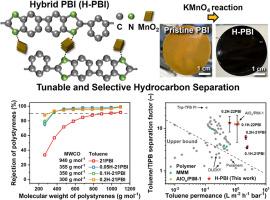在有机-无机杂化界面中裁剪二氧化锰纳米畴以实现可调碳氢化合物分离
IF 9
1区 工程技术
Q1 ENGINEERING, CHEMICAL
引用次数: 0
摘要
有机溶剂纳滤为烃类分馏提供了一种节能的替代方法。本文介绍了一种简单、可扩展的方法,以多苯并咪唑(PBI)和氧化锰(MnO2)为原料制备新型有机-无机杂化膜,用于复杂碳氢化合物的分离。均匀集成的MnO2结构域通过与PBI基质中的咪唑基团的氧化相互作用形成,创造了具有增强分子选择性的刚性杂化结构。通过系统地调整PBI浓度、KMnO4用量和反应时间,我们获得了低分子量截止(MWCO)低至266 g mol−1的膜。值得注意的是,这些膜超过了甲苯/1,3,5-三异丙苯分离的上限,并证明了对复杂碳氢化合物混合物(如石脑油)的有效分馏,富集了较轻的馏分。这项研究阐明了KMnO4在PBI修饰中的作用:它不是像之前建议的那样诱导直接的N-N交联,而是促进原位生成晶体MnO2结构域,从而增强膜刚性和分子选择性。这些发现强调了混合PBI膜作为膜辅助原油分馏的实用平台的潜力,并为先进的节能分离策略提供了前景。本文章由计算机程序翻译,如有差异,请以英文原文为准。

Tailoring MnO2 nanodomains in organic-inorganic hybrid interfaces toward tunable hydrocarbon separation
Organic solvent nanofiltration offers an energy-saving alternative to distillation for hydrocarbon fractionation. Here, we introduce a simple and scalable method for fabricating novel organic-inorganic hybrid membranes from polybenzimidazole (PBI) and manganese oxide (MnO2), designed for the separation of complex hydrocarbons. Homogeneously integrated MnO2 domains, formed via oxidative interaction with imidazole moieties within the PBI matrix, create a rigid hybrid structure with enhanced molecular selectivity. By systematically tuning PBI concentration, KMnO4 dosage, and reaction time, we achieved membranes with low molecular weight cut-off (MWCO) as low as 266 g mol−1. Notably, these membranes surpassed the reported upper bound for toluene/1,3,5-triisopropylbenzene separation and demonstrated effective fractionation of complex hydrocarbon mixtures, such as naphtha, enriching the lighter fractions. This study clarifies the role of KMnO4 in PBI modification: rather than inducing direct N–N crosslinking as previously suggested, it facilitates the in situ generation of crystalline MnO2 domains that bolster membrane rigidity and molecular selectivity. These findings underscore the potential of hybrid PBI membranes as a practical platform for membrane-assisted crude oil fractionation and offer prospects for advanced energy-efficient separation strategies.
求助全文
通过发布文献求助,成功后即可免费获取论文全文。
去求助
来源期刊

Journal of Membrane Science
工程技术-高分子科学
CiteScore
17.10
自引率
17.90%
发文量
1031
审稿时长
2.5 months
期刊介绍:
The Journal of Membrane Science is a publication that focuses on membrane systems and is aimed at academic and industrial chemists, chemical engineers, materials scientists, and membranologists. It publishes original research and reviews on various aspects of membrane transport, membrane formation/structure, fouling, module/process design, and processes/applications. The journal primarily focuses on the structure, function, and performance of non-biological membranes but also includes papers that relate to biological membranes. The Journal of Membrane Science publishes Full Text Papers, State-of-the-Art Reviews, Letters to the Editor, and Perspectives.
 求助内容:
求助内容: 应助结果提醒方式:
应助结果提醒方式:


